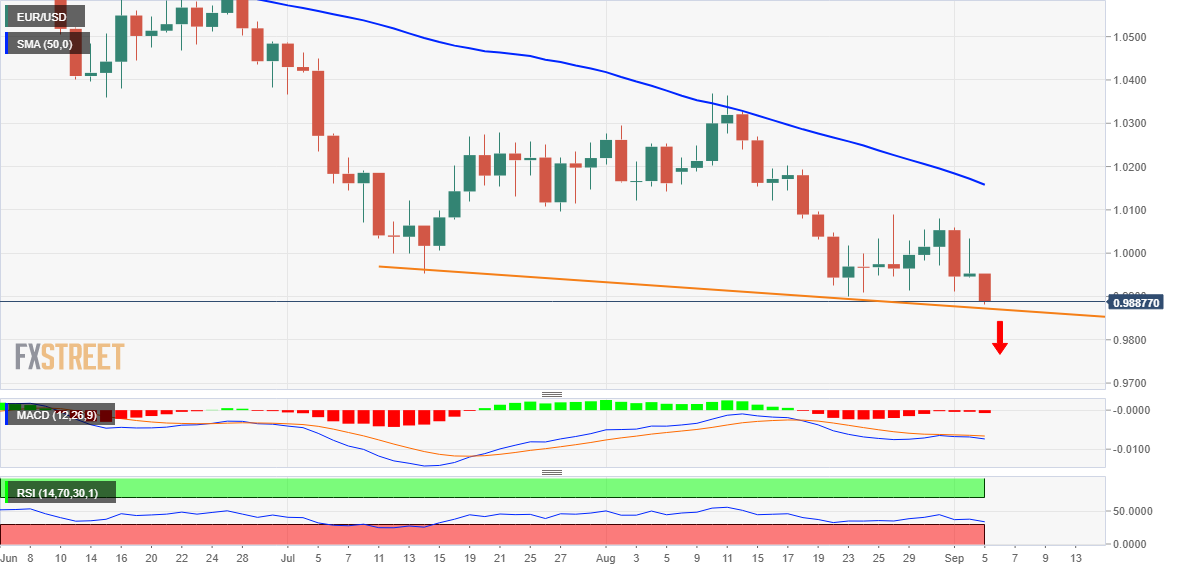- EUR/USD hits a fresh two-decade low and is pressured by a combination of factors.
- Russian gas cut stokes recession fears and weighs heavily on the shared currency.
- Hawkish Fed expectations continue to underpin the USD and contribute to the fall.
The EUR/USD pair opens with a modest bearish gap on the first day of a new week and drops to its lowest level since December 2002, below the 0.9900 mark during the Asian session. Russia's indefinite closure of its main gas supply pipeline stokes fears over a worsening energy crisis in Europe and weighs on the shared currency. Hours after the Group of Seven leaders agreed to implement a price cap on Russian oil, Gazprom cancelled the resumption of gas flows through the Nord Stream 1 pipeline citing an oil leak in a turbine. This, in turn, fuels worries about a potential economic recession in the Eurozone, which, along with a stronger US dollar, exerts downward pressure on the major. The USD Index, which measures the greenback's performance against a basket of currencies, rose to its highest level since late 2002 and remains well supported by hawkish Fed expectations.
Despite Friday's mixed US monthly jobs report, investors seem convinced that the US central bank will stick to its aggressive policy tightening path. The headline NFP showed that the US economy added 312K jobs in August, better than the 300K anticipated. This, however, marked a notable slowdown from the previous month's downwardly revised reading of 526K. Moreover, the US unemployment rate unexpectedly rose to 3.7% from 3.5% in July and Average Earnings growth slowed to 0.3% from 0.5% in the previous month. Nevertheless, the markets are still pricing a greater chance of a supersized 75 bps rate hike at the September FOMC meeting. This, in turn, remains supportive of elevated US Treasury bond yields and continues to act as a tailwind for the greenback.
The fundamental backdrop supports prospects for extending the recent bearish trend, though a combination of factors might help limit losses for the EUR/USD pair. Relatively lighter trading volumes on the back of the US Labour Day holiday should keep traders from placing aggressive bearish bets. Furthermore, calls for an unprecedented jumbo 75 bps interest rate hike by the European Central Bank could lend some support to the common currency. Hence, investors might prefer to move on the sidelines ahead of the key central bank event risk – the ECB policy decision on Thursday. Nevertheless, the path of least resistance for the major is to the downside and any attempted recovery would still be seen as a selling opportunity.
Technical Outlook
From a technical perspective, the EUR/USD pair is flirting with descending trend-line support extending from mid-July. A convincing break below will be seen as a fresh trigger for bearish traders and pave the way for additional losses. Spot prices might then accelerate the fall towards the next relevant support near the 0.9850-0.9845 zone before eventually dropping to the 0.9800 round figure.
On the flip side, the 0.9930-0.9935 region now seems to be an immediate hurdle. Any further move up runs the risk of fizzling out rather quickly near the parity mark. That said, sustained strength beyond might trigger a short-covering bounce towards the 1.0050-1.0055 supply zone, above which the EUR/USD pair could reclaim the 1.0100 mark. Some follow-through buying will suggest that spot prices have bottomed out and set the stage for a move towards the 1.0150-1.0155 intermediate hurdle en route to the 1.0200 round figure and the 1.0260-1.0270 resistance.






